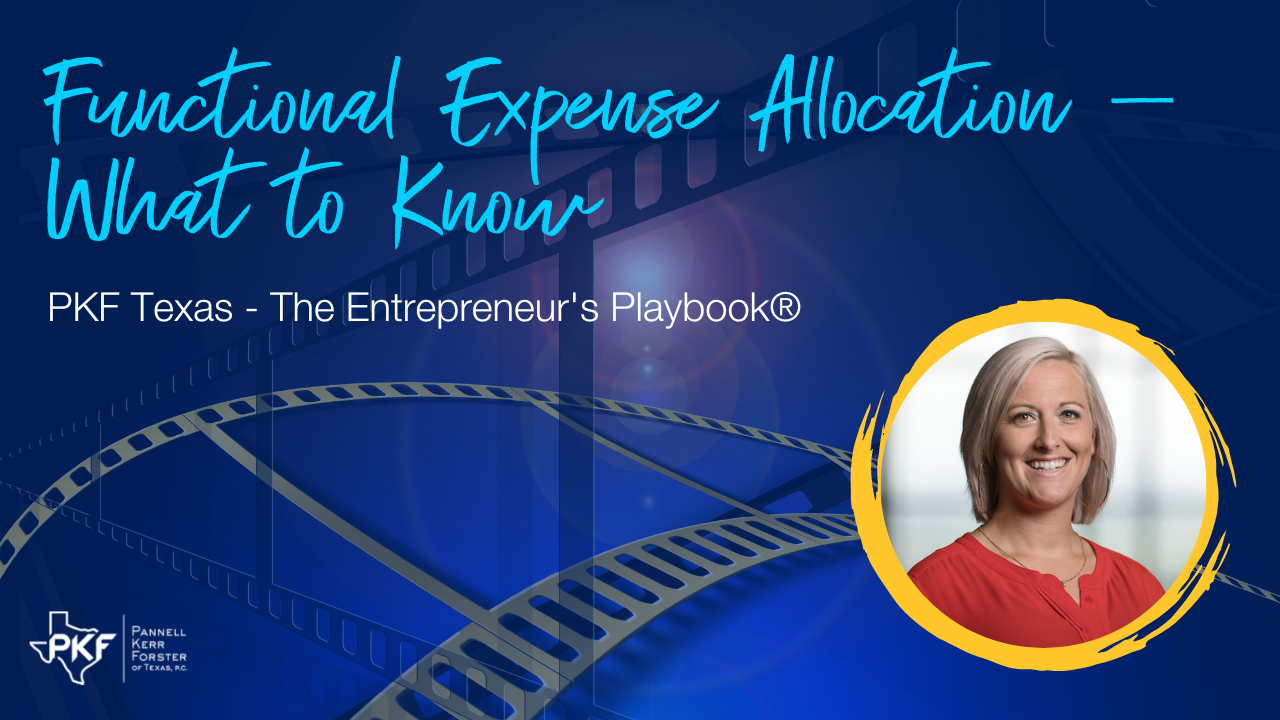Functional Expense Allocation – What to Know

Accounting rule changes now require all not-for-profit organizations to report their allocation expenses in their financial statements. Because it’s new and a big change, there are errors organizations encounter. Audit Director, Nicole Riley, CPA, CFE, discusses those errors and how to remedy them in this episode of PKF Texas – The Entrepreneur’s Playbook®.
Jen: This is the PKF Texas – Entrepreneur’s Playbook®. I’m Jen Lemanski and I’m back again with Nicole Riley, an Audit Director and one of our Approachable Advisors™ here at PKF Texas. Nicole, welcome back to The Playbook.
Nicole: Thanks.
What is Functional Expense Allocation?
Jen: So, I know in the past we’ve talked about functional expense allocation for not-for-profits. Can you remind our viewers what that is and why it’s important to a not-for-profit?
Nicole: Absolutely. So, Jen, a few years ago — it’s been quite a few now but — they changed the accounting rules and now require all not-for-profits to report their expenses in their financial statements by what’s called “natural classification” and “functional classification.” And what that really means is you have to show each of these expenses by the type of expense they are. So, whether it’s salaries and wages, office expenses, occupancy, you need that information.
But then you have to show how those expenses are then related to their functional classification. How much is program, how much is management in general, and how much is fundraising? And that’s a big change because previously it only was for health and welfare organizations. So, now that all organizations have to do it, it’s been a little bit of a change.
Common Errors to Watch Out For
Jen: It’s a big difference. So, are there any common errors you see as people are working through this process?
Nicole: Yeah, unfortunately, even though we’re five years in, we’re still seeing some pretty significant issues. The main issue I see is just the organization doesn’t have a stated policy or it hasn’t really thought through what allocation makes best sense. You know, for example, if you have a building, the expenses that relate to the building, such as insurance or rent, utilities, those need to be allocated based on how the building’s being used.
So, I see that they either don’t allocate them at all – they put them all program or all management in general, which is, is not right, you know. Or they just don’t use an allocation method that makes sense. You know, for example, if 95% of your building is your warehouse for your program, it probably makes sense to use a square footage allocation method versus your payroll time and effort allocation. But on the flip side, things like office expenses, maybe your payroll allocation makes more sense because that kind of correlates to who’s using the office supplies a little bit more.
Recommendations
Jen: So, it sounds like there’s a lot to consider. Do you have any recommendations for organizations as they’re looking at this?
Nicole: I just really encourage people to take the time to document their allocation procedures and what they decide to do and make sure that they’re reasonable and consistently applied. You know, if they just take the time to write it down, have it documented…
Because a lot of times what we’re seeing now is their staff changes, and when their staff changes, nobody has any idea how it was done previously. So, it’s hard to be consistent if you have no documentation of what was done previously. But it’s also really hard to know what makes sense and you have to do all of that work all over again.
So yeah, document that allocation what you decide what makes sense. Take the time to make sure that you’ve picked the right stuff because at the end of the day, that schedule is now audited. It’s part of your audited financial statement, so it has to be materially correct.
And then you also have to remember you have donors that look at that information on your 990 too and want to see how you’re doing as an organization and how you’re utilizing the funds that you’ve been given. So, I think it’s really important just to take a little time and give a little effort to make sure it’s right and done right the first time.
Jen: Perfect. Well, we’ll make sure that our clients document their processes. All right. We’ll get you back to talk a little bit more about some other issues for not-for-profit. Sound good?
Nicole: Sounds great.
Jen: This has been another thought leadership production brought to you by PKF Texas – The Entrepreneur’s Playbook®. For more information about this topic, visit www.pkftexas.com/NotForProfit. Tune in next week for another chapter.

